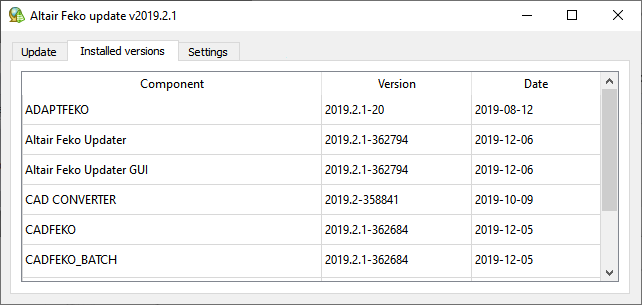Viewing the Installed Component Versions
View the version numbers of the installed Feko components.
See what's new in the latest release.
The Feko Getting Started Guide contains step-by-step instructions on how to get started with Feko.
The Feko Example Guide contains a collection of examples that teaches you Feko concepts and essentials.
Feko is a comprehensive electromagnetic solver with multiple solution methods that is used for electromagnetic field analyses involving 3D objects of arbitrary shapes.
CADFEKO is used to create and mesh the geometry or model mesh, specify the solution settings and calculation requests in a graphical environment.
POSTFEKO, the Feko post processor, is used to display the model (configuration and mesh), results on graphs and 3D views.
EDITFEKO is used to construct advanced models (both the geometry and solution requirements) using a high-level scripting language which includes loops and conditional statements.
One of the key features in Feko is that it includes a broad set of unique and hybridised solution methods. Effective use of Feko features requires an understanding of the available methods.
Feko offers state-of-the-art optimisation engines based on generic algorithm (GA) and other methods, which can be used to automatically optimise the design and determine the optimum solution.
The Feko utilities consist of PREFEKO, OPTFEKO, ADAPTFEKO, the Launcher utility, Updater and the crash reporter.
Use PREFEKO to perform meshing and to prepare the input files for the Feko solver.
Use PREFEKO with the correct syntax and optional parameters for advanced control.
The Solver is the electromagnetic solver component that calculates the specified output requests.
OPTFEKO is the component that controls the optimisation process. The optimisation parameters are usually associated with geometric dimensions, material properties, excitations and loadings. For example, the gain of a horn antenna is maximised by varying the size of the horn aperture.
ADAPTFEKO is the adaptive frequency utility used to automatically select smaller frequency steps near narrow resonances and larger steps where the results are relatively smooth.
The initfeko.bat (batch file on Windows) and initfeko (bash shell script on Unix / Linux) scripts are executed from a terminal to configure the Feko environment. From this environment, the Feko applications can be launched without using their full path.
The Launcher utility is a single application that allows you quick access to the shortcuts for the Feko components, WinProp components, newFASANT, documentation, Altair license utility and updating parallel credentials. Pin the application to the taskbar for quick launching.
The feko_update_gui utility and the feko_update utility allows you the flexibility to install an update containing features, minor software enhancements and bug fixes on top of an existing base installation for Altair Feko (which includes Feko, newFASANT and WinProp).
Each major release, upgrade or update is assigned a version number. A version number contains a unique set of numbers assigned to a specific software release for identification purposes. You can determine from the version number if its an initial release, update or upgrade.
Use the feko_update_gui to check for new versions of the software and install an update using a graphical user interface (GUI).
View the version numbers of the installed Feko components.
Updating and upgrading refers to the process of installing a new version containing features, minor software enhancements and bug fixes on top of an existing base installation.
Update (or upgrade) from a local repository using the graphical user interface.
Schedule and configure an automatic Feko update.
Use the feko_update utility for scripted updates or updates from a Feko terminal.
The feko_update_gui utility and feko_update utility (GUI and command line) use the system proxy by default, although it may be changed or the use of a proxy suppressed.
Create a local Feko update repository to allow users to update without internet access or to limit the list of update versions that users can use. Local update repositories can also be used to reduce the amount of data being downloaded by downloading a repository once and making it available to many local machines or compute clusters.
In the event of a crash occurring in CADFEKO, POSTFEKO or EDITFEKO, the crash report utility generates a crash report.
QUEUEFEKO is a graphical user interface (GUI) application that can create a package which you can transport to a remote queuing system. Created packages can be extracted once the simulation on the queuing system has been completed.
Feko writes all the results to an ASCII output file .out as well as a binary output file .bof for usage by POSTFEKO. Use the .out file to obtain additional information about the solution.
A large collection of application macros are available for CADFEKO and POSTFEKO.
CADFEKO and POSTFEKO have a powerful, fast, lightweight scripting language integrated into the application allowing you to create models, get hold of simulation results and model configuration information as well as manipulation of data and automate repetitive tasks.
Reference information is provided in the appendix.
The Feko utilities consist of PREFEKO, OPTFEKO, ADAPTFEKO, the Launcher utility, Updater and the crash reporter.
The feko_update_gui utility and the feko_update utility allows you the flexibility to install an update containing features, minor software enhancements and bug fixes on top of an existing base installation for Altair Feko (which includes Feko, newFASANT and WinProp).
Use the feko_update_gui to check for new versions of the software and install an update using a graphical user interface (GUI).
View the version numbers of the installed Feko components.
View the version numbers of the installed Feko components.

(c) 2021. Altair Engineering Inc. All Rights Reserved.